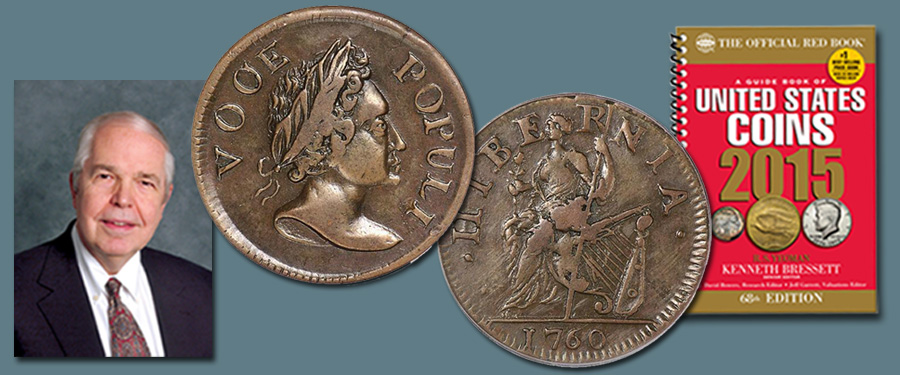
Welcome to my latest travels through the pages of A Guide Book of United States Coins, the eminently useful Red Book that first appeared in 1946 and is now in its 69th edition with a cover date of 2016. I am the research editor for the book, while the senior editor is Kenneth Bressett and the valuations editor is Jeff Garrett. Each year the preparation of the Guide Book takes many months at Whitman headquarters in Atlanta, Georgia, as collectors, dealers and others contribute changes in prices and other information. For this coming year I hope to go over the book word for word, line for line, and suggest some changes in mintages, terminology and the like. Added to this will be items in a file kept at Whitman from others who suggest changes. No two editions are ever alike. Each one is necessary and important in its own right.
This week I continue on page 49, with the section titled “Hibernia-Voce Populi Coins.” These pieces were struck in Dublin, Ireland, by a Mr. Roche in 1760. The legend on the obverse, VOCE POPULI, is similar to VOCE POPOLI, or “the voice of the people,” found on the 1783 Georgivs Triumpho token which I will discuss later. In the meantime you can check it out on page 79.
Returning to page 49, the reverse word HIBERNIA is the ancient term for Ireland. These particular coins were made for distribution in that country and had nothing whatsoever to do with the American colonies. Today they are numismatic cowbirds in a way, appearing where they shouldn’t be. The reason Americans collect them is that they are slightly similar to the Wood’s Hibernia coinage discussed earlier, which also had nothing to do with America, but was slightly related to the Rosa Americana coinage that did pertain to this side of the Atlantic. Are you still following this?
The 1760 Voce Populi coins were ignored by Sylvester S. Crosby in his monumental The Early Coins of America, 1875, and similarly were ignored in Wayte Raymonds issues of the Standard Catalogue of United States Coins until Walter Breen revised the section on colonials in 1954 and added them. Raymond’s catalog expired in 1957. John J. Ford, Jr. had the rights to it and wanted to continue it. At one time he asked me if I would be editor but I demurred for lack of time. I was quite busy with my own growing business and, at the same time, studying at the Pennsylvania State University. By 1957 sales of the Guide Book of United States Coins had far eclipsed the somewhat sleepy Standard Catalogue and it in a way died a natural death.
On the 1760 pieces there are several different portraits. Robert Vlack, a prominent student of colonial coins, suggested that among those represented might be George II, George III (does not seem as likely to me), a pretender who claimed to be James III, the young pretender Charles Edward, and Healy Hutchenson (provost of Dublin College). He further suggests that the raised letter “P” which appears on some issues in front of the bust or below it may relate to “princepts” as pertaining to Charles Edward or “provost” as relating to Healy Hutchenson. As is so often true in coinage of the 18th century, facts are scarce.
Most pieces found in collections today trace their origins to British dealers. At auction they often bring handsome prices, this being particularly true of the farthing or one-quarter penny denomination. If the Guide Book needs space and decides to drop these issues, watch out! Likely, that won’t happen as they have been adopted into the American coin family, so to speak, and will probably not be ejected.
See you next week!





